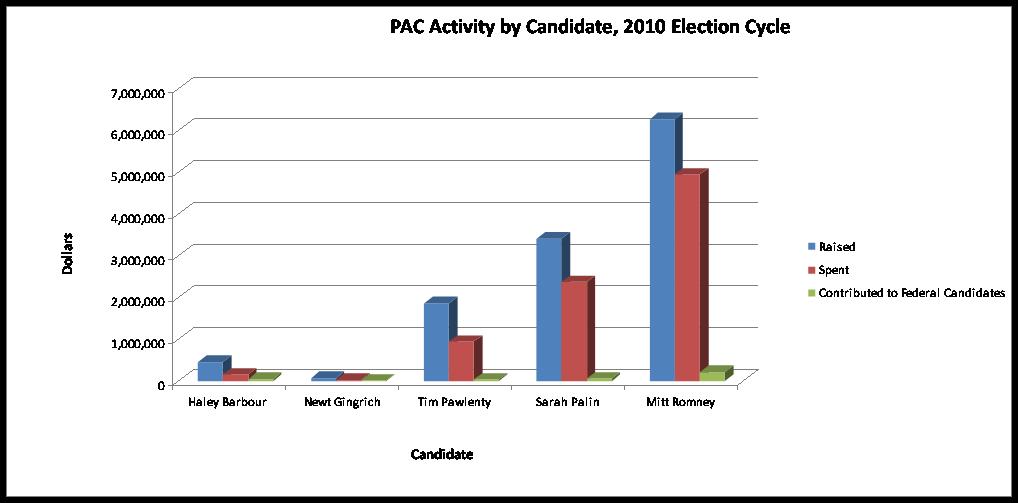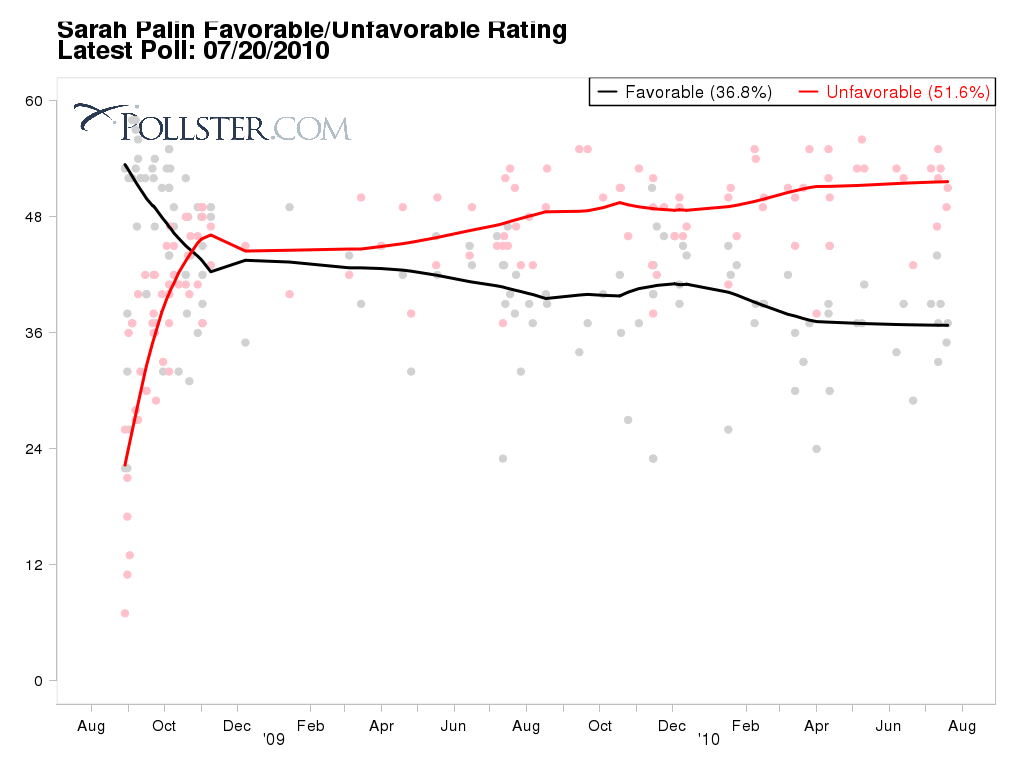I just received James Carville’s latest fundraising letter on behalf of the Democratic Congressional Campaign Committee (don’t worry, I get them from the Republicans too – it’s my job.) Featured prominently on the envelope is a not very flattering picture of Sarah Palin, in full snarl. She looks like she just saw Katie Couric move in next door. Inside, in bold type, Carville warns me that “Palin’s summer of lies road trip is in full swing”, and that she’s “already campaigned for more than a dozen tea party lunatics running for Congress” and has plans to stump for many more.
The fundraising letter reminds me just how formidable a political figure Palin has become. It was little more than a year ago that critics sounded her political obituary in the wake of her decision to quit her position as Governor of Alaska. Now, if Carville is to be believed, she has become the de facto face of the Tea Party, and a leading figure in the Republican Party, one whose political endorsement is perceived to carry great weight. How did she manage to escape the political oblivion to which her critics consigned her?
In retrospect, the decision to quit the governor’s position looks like a stroke of pure genius – whether or not she actually plans to run for President. To begin, it freed her to raise money much more easily than she could have done if she remained in Alaska. Consider the latest fundraising totals for SarahPAC – her leadership PAC – as reported to the FEC. It is her best showing to date, and she trails only Romney among potential Republican presidential candidates in fundraising in the 2010 electoral cycle. (Note that at the time this chart was created it did not include Pawlenty’s totals for the 2nd quarter 2012.)
This money is important for three reasons. First, as the Carville fundraising letter notes, Palin is piling up political IOU’s through judicious use of campaign contributions. Second, it serves as important “seed” money with which to build the infrastructure of an effective fundraising organization – a necessity if she’s going to be a serious presidential contender. Note that to date most of her money has been raised through social networking sites, like Facebook. This is in stark contrast to Romney, who has a full-fledged fundraising infrastructure already in place from his 2008 presidential run. (Palin’s 2008 fundraising was controlled by McCain). Finally, and not least, the media uses fundraising to measure candidate viability in the “invisible primary” that precedes the actually nominating process. Because the media is not very good at juggling multiple candidate story lines, however, it is crucial that Palin create the perception that she is one of the top-tier candidates. Moreover, she is touting her ability to attract “small” donations – those less than $200 which formed a significant portion of her latest fundraising totals. About 50% of those who contributed money during the second quarter gave less than $200. That compares with the first three months of 2010, when SarahPAC earned about $400,000, with small donors making up only 25% of contributors. (Recall that this is precisely how Obama’s candidacy was deemed credible by the media – all those “small donations” [which turned out not to be so small!] propelled him into the top tier of prospective presidential candidates.) In terms of media perceptions, Palin will pass that viability threshold if her fundraising total continues to rank among the top 2-3 candidates. As these news stories make clear, the media is beginning to portray her as a serious candidate, as opposed to the previous narrative in which she was portrayed as Governor Quitter.
The second criterion by which the media assesses candidate viability during the invisible primary is trial heat and other polling results. Here again, Palin may yet confound the critics; the latest PPP survey of “American Voters” has her in a dead heat with Obama.
Q8 If the candidates for President next time were Sarah Palin and Barack Obama, who would you vote for?
Sarah Palin …………………………………………….. 46%
Barack Obama………………………………………… 46%
Not Sure…………………………………………………. 9%
In assessing this poll, however, keep in mind that Obama was tied with or behind almost any Republican candidate with whom he was matched in a hypothetical vote. So this says less about voters’ attitudes toward Palin than it does their feelings about Obama. Moreover, other polls taken earlier this month have Palin trailing Obama by significant amounts. I can’t believe she’s closed the gap that much in a matter of days. In any case, it is far too early to take these trial heat polls for 2012 matchups very seriously.
My point is simply that far from being finished, Palin is by any measure a significant player in American politics today. The question becomes: how did she pull this off? One clue comes by viewing her latest fundraiser video. In it, she comes closer to capturing the spirit animating the Tea Party movement than does any other Republican candidate I’ve seen so far. And the video goes a long way toward illustrating the strengths – and the weaknesses – of a potential Palin presidential candidacy.
To begin, the video tries to do something that is not easy: to both register anger at the direction the country is going, but also to strike an uplifting tone, suggesting better times are ahead. The target audience is clearly one that is crucial to any Republican hoping to recapture the White House in 2012: women. The video is, at its core, about women and directed toward women – almost all the faces are female, mostly white, across a range of ages.
Note that the video is almost devoid of any policy references, beyond a mild jab at the recently pass health care plan. Instead, it tries to capture the sense of unease that is driving the tea party movement by focusing on enduring values that Palin suggests we are in danger of losing.
The video is a reminder that Palin’s candidacy is fueled by discontent more than a set of political principles, and that she is marketing a personal image more than a clearly honed political philosophy. Consider the very name of her leadership PAC – SarahPAC – it is focused on her. Her rivals, in contrast, have named their PACs for political ideals – see Romney’s FreeStrongAmerica PAC, or Pawlenty’s FreedomFirst PAC (The exception is Huckabee’s HuckPAC.)
Why, then, do I suggest the video also indicates her weakness as a candidate? Despite the uplifting tone, it possesses an underlying edge. The Mama Grizzly isn’t nurturing her cubs – she’s rearing up on her hind legs to defend them. The pink elephants? Ready to stampede Washington in 2010. That effort to play both nurturing and avenging mother proved very polarizing during the 2008 campaign, I argued then, and the evidence suggests it continues to do so today. Palin the person remains immensely attractive to a significant portion of the population. But another portion dislikes her intensely. Not surprisingly her favorability ratings have if anything dropped during the last year, to just under 40%, while a bit more than half of those surveyed now view her unfavorably.
It is not clear to me that it will be possible for Palin to reverse these numbers and broaden her political support. Her biggest advantage, I think, is that liberal pundits continue to dismiss her as an intellectual lightweight who can’t think and put on lipstick at the same time. That sentiment feeds the populist sentiment that is driving both her undeclared candidacy and the Tea Party movement more generally – that there is a Washington, DC-centered “elite” that is out of touch with the concerns of “ordinary” Americans. If Palin can successfully position herself as the face of this movement – something the Carville letter suggests she is doing – she may yet “refudiate” her critics one more time.
Addendum: Brendan Nyhan has an interesting post comparing Palin’s polarized support with Hillary Clinton’s, and suggesting how Palin might learn from Clinton regarding how to reduce that polarization.


Palin’s credibility has been undermined by her failed endorsement of Kelly Ayotte in New Hampshire. A PPP survey this week demonstrated that the endorsement “negatively impacted the opinion of almost a third of Republicans and over half of all New Hampshire voters.” 65% of moderates were LESS likely to support a Palin-endorsed candidate. Palin’s brand might play well among primary voters in Iowa and South Carolina, but without even a top 3 finish in NH, she’ll be pretty damaged and the media storyline that she is the “inevitable” nominee just won’t happen. And if she does somehow manage to win the nomination, the fact that she plays so poorly among independent voters in a swing state like NH translates to electoral failures across the board. She certainly shouldn’t be counted out, especially financially, but she has to cut the alienating rhetoric if she ever wants to be a truly national candidate and not a sectional one.
Charlie – As longtime readers know, I am skeptical that endorsements make as big a difference as the media often implies. I don’t think I’d go as far as you do in saying “Palin’s credibility has been undermined by her failed endorsement” of Ayotte. In fact, 38% of those surveyed said it would make them more likely to vote for Ayotte, while 28% said less likely and 34% said it would make no difference. This is hardly failure! And if Ayotte goes on to win the primary – and she’s way ahead in the polls, although there is a month and a half before it is held – the media spin will be that another one of Palin’s endorsed candidates won – whether or not her endorsement really mattered all that much.
I find more to agree with in your assessment of her 2012 presidential prospects although again, it is far too early to have any confidence in our projections. Nonetheless, the PPP poll does ask Republican voters about the various potential Republican presidential nominees. Not surprisingly, the favorite son Romney leads everyone with 31% support. Palin is bunched with four others (Paul, Gingrich, Pawlenty and Huckabee) all of whom are separated by amounts that fall within the poll’s 4% margin of error. Keeping in mind that Paul isn’t likely to run, all Palin needs to do is secure the “not Romney” vote in NH to stay alive.
Likely? I don’t think so. Impossible? No.
Matt, you write, “…the decision to quit the governor’s position looks like a stroke of pure genius – whether or not she actually plans to run for President. To begin, it freed her to raise money much more easily than she could have done if she remained in Alaska.”
But you overlook what I believe is a fundamental element in Palin’s decision–to make a ton of money. And that ties directly into her relations with the Mainstream Media, i.e., Fox News. So it was fundamentally both a personal and power decision.
Marty – I don’t think we are in disagreement here. I don’t know how much the desire to make money played into Palin’s decision to resign but her ability to do so is directly linked, I think, to the possibility that she might run for president. Lacking that dimension, her ability to raise money is diminished because she’s simply a less interesting person – the ex-governor of Alaska, rather than a potential presidential candidate in 2012. So the two motives – whatever the relative weight one puts on them – both point in the same direction: resigning the governorship was a stroke of genius, not the career-ending move that many predicted.